This is the second entry in the series “Independent Study in World Cinema,” in which this self-educated film nerd attempts to fill in some fairly serious gaps in his self-education. (For a fuller explanation of this project, read the first entry in the series.) This week, I take a long look at the movie that—for better or worse—started cinema's love affair with vampires: F.W. Murnau's Nosferatu: A Symphony of Horror (1922).
Background
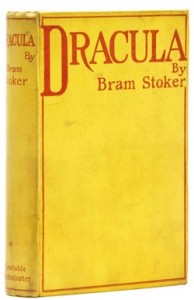 Released in March of 1922, Nosferatu: A Symphony of Horror (Nosferatu, eine Symphonie des Grauens) has the honor of being the first film adaptation of Bram Stoker's 1897 novel Dracula. (A now-lost Hungarian film called Dracula's Death [Drakula halála] premiered in 1921, but this appears to have been an unrelated story, not an adaptation: one suspects the Hungarians were simply trading on name-recognition.)
Released in March of 1922, Nosferatu: A Symphony of Horror (Nosferatu, eine Symphonie des Grauens) has the honor of being the first film adaptation of Bram Stoker's 1897 novel Dracula. (A now-lost Hungarian film called Dracula's Death [Drakula halála] premiered in 1921, but this appears to have been an unrelated story, not an adaptation: one suspects the Hungarians were simply trading on name-recognition.)
Nosferatu also has the honor of being the film that launched, and sank, a studio. It was the first film from Prana-Films, an independent German studio established by producer and production designer Albin Grau and producer Enrico Dieckmann. Grau—who, as Raymond Owen discusses here, was a noted occultist—intended Prana to produce films on occult themes, and for their first venture he hired Henrik Galeen to pen, and F.W. Murnau to direct, an adaptation of Stoker's popular vampire novel.
Unfortunately, Prana was unable to actually secure the rights to Dracula from Stoker's widow, Florence, and so they chose to simply change the title of the film and the names of all the characters: Count Dracula became "Count Orlok," Jonathan and Mina Harker became "Thomas and Ellen Hutter," Renfield became "Knock," and vampire hunter Abraham van Helsing became "Professor Bulwer, a Paracelsian." (Galeen's original script, with the character names from Stoker's novel, has survived: it is otherwise nearly identical to the finished film.)
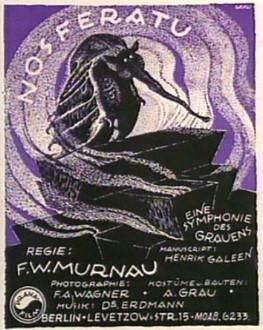
Surprisingly, this clever subterfuge did not fool Florence Stoker, who—quite appropriately—sued Prana for copyright infringement. Nosferatu had already opened to lukewarm reception, and the lawsuit was the death knell for the film: in 1925, the courts ordered all copies of the film turned over to Stoker's estate for disposal. Prana went out of business, and all official copies of Nosferatu were destroyed. However, a print of the film had made it's way to America, where—due to a copyright snafu—Dracula was already in the public domain. Bootleg copies—many of them horrendously edited—proliferated from there, making—as Felicia Feaster at Turner Classic Movies says, "the search for the 'original,' 'uncut' Nosferatu a film historian's obsession."
The film was only really rediscovered in the 1960s, and in the decades since it has been rightfully recognized as a masterpiece of German Expressionism, and one of the most important and influential films of the silent era. Due to the film's tortured history and its long life in the public domain, countless edited and bootleg versions of the film are widely available, and most of them are fairly terrible, with chopped-up scenes, crappy music, and poor (or missing) intertitles; many of these public domain versions are in black-and-white, neglecting the color tinting that Murnau clearly intended. These, obviously, should be avoided. (The print, music, and intertitles on the version streaming on Netflix, for example, are all kind of appalling.)
For my viewing, I chose the gorgeous high-definition restoration, which was painstakingly undertaken by the F.W. Murnau Foundation in 2007. It's a crystal clear remastering of the film (using footage selected from the best of the various surviving prints), features a new performance of Hans Erdmann's original score, and restores the look of the original intertitles and inserts. I don't know if this is Nosferatu exactly as Murnau intended, but I think it's safe to say this is the closest we're going to get unless some heretofore unknown print turns up. It's available on DVD from Kino, and online rental at Amazon.
Introduction
Let me state at the beginning that future installments of this series will not—God willing—be as long as this one. But I let myself take my time with this one for a couple of reasons. The first is that I am still feeling my way: my goal with this project is to stumble my way through a self-guided, remedial film school, and—as I've said before—writing about things is how I force myself to look at them more closely and understand them better. So—especially in these early films—I want to do more close-reads of individual scenes, and even individual shots, than I normally do in my reviews. I expect to get more efficient as I go along.
The second reason, however, is that it was only by doing this that I learned to love Nosferatu: on first viewing, for reasons we'll discuss, I was not a huge fan.
Don't get me wrong: I could understand the film's importance in movie history, and it would be impossible not to recognize the talents of its director, F.W. Murnau. I will not attempt to speak to all of the film's innovations—nor claim to be qualified to do so—but even just comparing it to last week's entry, The Cabinet of Dr. Caligari, we can see that Nosferatu represents a quantum leap forward for the relatively newborn art of cinema. Where Caligari was studio-bound, Nosferatu is shot—magnificently—on a wide variety of locations. Where the former featured static scenes and very little editing, the latter effectively utilizes intercutting, montage, and an array of other effects to achieve a richer, more sophisticated narrative. Where Caligari feels like a masterfully-realized short story, quick and powerful in its effect, Nosferatu—though only 20 minutes or so longer—feels epic in its scope, a huge and unwieldy novel of a movie. To mix my metaphors further—drawing now on the one Murnau used—if Caligari is a suite, Nosferatu is—as its original subtitle proclaims it—a symphony.
And yet watching Nosferatu the first time, this is how I find myself reacting to it: as an important transitional work in the history of film, and not as a powerful story in its own right.
However, though I still have problems with the film in places, subsequent viewings and closer examination—described below—have reinforced my long-held belief that over-analyzing something to death is really the best way to appreciate it. I'm not going to attempt to formulate a coherent thesis, or try here to resolve the many marvelous themes and ambiguities that are at work in Nosferatu, but looking at it closely, and identifying a fraction of what is happening here—even in my shallow, haphazard way—has made me realize what a rich and rewarding film it is.
Act I
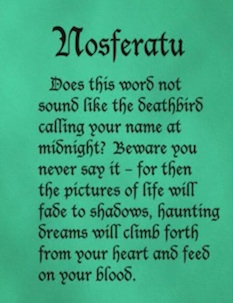 Nosferatu begins with inserts of a manuscript, which frames the entire story we're about to hear as one (unnamed) narrator's "Account of the Great Death in Wisborg" in 1838. While in general I find Nosferatu to be a little over-dependent on inserts and intertitles, it's hard to fault these. In the first place, they—and several other such intertextual inserts throughout the film—are a clever way of evoking the experience of Bram Stoker's Dracula, which is a novel composed of letters, journals, ships diaries, and newspaper clippings. In the second place, our unnamed historian efficiently and effectively establishes the mood and several themes of the film, including death, parasitism, the play of light and shadow, and the suggestion that monsters can emerge from our own subconscious fears and desires: dreams that “will climb forth from your heart" to overwhelm the "pictures of life." For the opening two sentences of an Expressionist horror film, it's hard to imagine doing any better than that.
Nosferatu begins with inserts of a manuscript, which frames the entire story we're about to hear as one (unnamed) narrator's "Account of the Great Death in Wisborg" in 1838. While in general I find Nosferatu to be a little over-dependent on inserts and intertitles, it's hard to fault these. In the first place, they—and several other such intertextual inserts throughout the film—are a clever way of evoking the experience of Bram Stoker's Dracula, which is a novel composed of letters, journals, ships diaries, and newspaper clippings. In the second place, our unnamed historian efficiently and effectively establishes the mood and several themes of the film, including death, parasitism, the play of light and shadow, and the suggestion that monsters can emerge from our own subconscious fears and desires: dreams that “will climb forth from your heart" to overwhelm the "pictures of life." For the opening two sentences of an Expressionist horror film, it's hard to imagine doing any better than that.
Also, by calling his story an account of "The Great Death," this narrator suggests an association both with the "Great War" so recently ended and—more importantly—with the epidemic of Spanish Flu that had, only a few years earlier, ravaged Europe and infected a fifth of the world's population. The threat of invasion by foreigners, and the fear of disease—both so fresh in the minds of Murnau's audience—are two of the prevalent fears Murnau will exploit in Nosferatu.
(While we're here, an interesting point about the title of the movie: the very meaning and etymology of the word "nosferatu" is a matter of dispute. Stoker used it as a Romanian word meaning "vampire" or "undead," but there appears to be disagreement about this point, with many scholars arguing that the term originates in the Greek word "nosophoros," meaning plague-carrier. The Wikipedia page on this topic is topic is surprisingly comprehensive, if you're interested. I, of course, have no idea who is right, but it is very clear to me that Murnau knew of both meanings and was consciously keeping them both in play.)
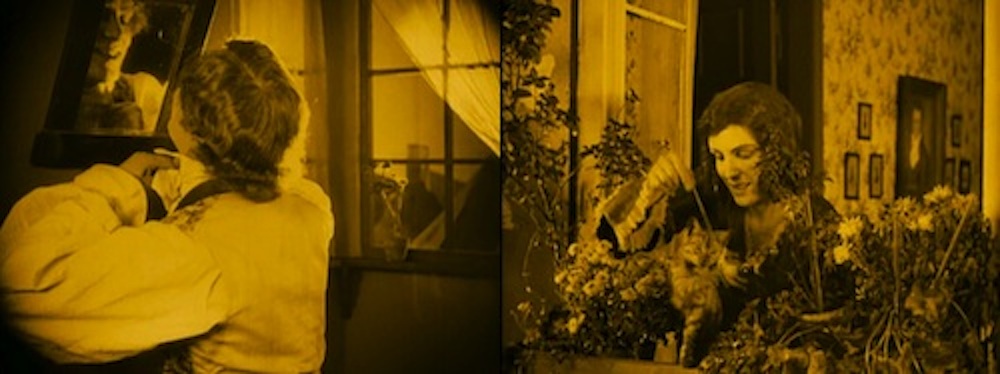
Next we are introduced to our heroes, Thomas and Ellen Hutter. The first shot of each of them is interesting: Hutter—who, frankly, will never come across as particularly bright—is seen in an act of vanity, smiling stupidly at himself in the mirror as he readies himself for work. Perhaps it's only the recent example of Caligari influencing my reading here, but I suspect one could write an entire treatise on the symbolism of windows in German Expressionism: I'm not going to attempt it, but I find it interesting that a) Hutter is turned away from the window, towards himself; and b) that what we see through his window is rooftops and chimneys, signs of industrialization and urban life. Compare this to the first shot of Ellen, in which she is in the window, looking out, surrounded by flowers, playing with a cat. It's a marvelous contrast, done efficiently: Hutter is a creature of masculinity, industry, rationality, and self-obsession, while Ellen is feminine, at one with nature, emotional, and attuned to the world. (Windows are hugely important in the film, and Ellen, in particular, will spend a great deal of time looking out them.)
These different sensibilities—and different attunings to nature—are reinforced a few minutes later, when Hutter—trying to be kind—cuts some flowers from the garden to surprise his wife. The act, which is meant to please her, instead makes her sad. "Such beautiful flowers," she says. "Why did you kill them?" As for which sensibility the film prioritizes and celebrates, there's no contest: throughout the movie, Ellen is seen as fragile, delicate, and something to protected, but time and again she turns out to be the one with all the power, the one capable of saving the day. (A truth that is subtly foreshadowed here; she plays with a cat, in a film in which evil is represented by rats.) She—not he—is the one who is equipped to deal with the nightmares to come.
This is a film on which volumes could be—and have been—written, and it would be impossible for me to do justice to every aspect here. Certainly, however, one way to interpret Nosferatu is to see it like a dream, as a story in which all of the figures really represent different aspects of the dreamer. In this reading, Ellen and Hutter are not simply—or even primarily—characters the way we think about them, but different expressions of a single soul. (We will see later that they share a literal psychic link, as well as a thematic one.) Orlok, and Knock, and Bulwer, and the various townsfolk are not characters either, but representations of the forces within that soul that speak to it, and pull it, and, at times, threaten to destroy it. I'm only going to do so much with this, but I mention it here because it makes the way gender is explored in this film fascinating: I find it interesting, for example, that Hutter is played by a rather feminized man, and Ellen is played by an extremely masculine woman (to the extent that I honestly did a Google search to see if Greta Schröder was a man in drag). Murnau himself was gay, and though I would not want to make too much of that, there are some very interesting things happening with the feminine in the masculine, the masculine in the feminine, and with the erotic threat represented by Count Orlok, who climbs into bed with both Hutter and Ellen. Plenty has been written on these topics, and I'll link to a couple of interesting articles in the Bibliography below.)
One interesting (and troubling) theme that we should discuss a bit is the subtext of anti-semitism that runs (never very far beneath the surface) throughout Nosferatu; frankly, I don't see how we can avoid it. Much of this, of course, is inherited from Bram Stoker's novel, in which—as discussed in this summary of the arguments of scholar Sara Libby Robinson by Allan Nadler—“Stoker's depiction of Dracula exploited widespread anxieties about the dangers posed by the flood (and the blood) of Yiddish-speaking immigrants to Great Britain.” Those same anxieties were rampant in 1920s Germany, of course, and were being intensified by a huge influx of Jewish immigrants moving westward from Eastern Europe in the aftermath to the First World War and the Russian Revolution.
I'm not going to dwell overlong on the history—we all know how things worked out for the Jewish population in Germany—and I do not claim to know enough to suggest that Murnau, or Galeen, or Grau were setting out to make a deliberately anti-semitic film. However, the way Nosferatu reveals and exploits these prejudices and stereotypes is unmistakable. The first sign we get of this is in the character of Knock, a real estate broker and Hutter's boss. Knock is never identified as Jewish—nor is Orlok—but an interesting intertitle informs us that he was a figure "about whom all sorts of rumors circulated," and that "the only thing for certain was that he paid his people well."
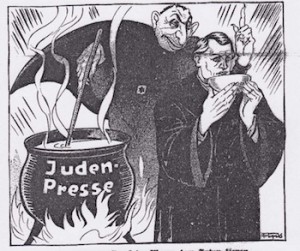
As Orlok will later, Knock personifies nearly every negative stereotype of Jews that was prevalent at the time, from his ratlike physical appearance—the bushy eyebrows, the hook nose, the gnomelike physiognomy—to his greedy, money-mad demeanor and his willingness to aid the enemies of Germany. (There was a widespread conspiracy theory at the time that Germany's defeat and surrender in 1918 was the result of internal subversion by "liberals, Socialists, and Jews.") Knock is Orlok's agent in Germany, and sends Hutter to Transylvania—“the land of phantoms and thieves”—to broker a deal for Orlok to purchase a house in Wisborg. (In fact, it's the house directly across from Hutter's own.) Interestingly, Knock is acting on instructions he receives in an indecipherable letter: the coding here, too, seems very clear: the writing is a mishmash of cabbalistic symbols (including, in places, an arcane Star of David), which appears to read—like Yiddish—from right to left.
Hutter leaves Ellen—who is devastated at the thought of their separation—in the care of some friends, and journeys from Wisborg to Transylvania, in Romania, nestled in the Carpathian Mountains. Here we see for the first time Murnau's truly stunning location shots, as he often lets his camera track over the scenery, or simply linger over the sun through the clouds. (Many of these shots also have a practical purpose: to alert the viewer to a transition from day to night. The film will be in warm sepia tones, and then we'll get a shot of the sky, and Hutter will comment that it is getting dark; a scene or two later the screen will be green-tinted or blue-tinted, indicating dusk or darkness.)
Hutter stops first at an inn, where the peasants seem terrified at the mention of Count Orlok, and urge him not to journey by night because of werewolves. (A shot of a hyena prowling the hills and chasing horses aids the sense of the dangers of this wilderness, if not of supernatural threats.) Hutter stays the night, and in his room he discovers a book the peasants have placed there: a treatise on "Vampyres, Phantoms, and the Seven Deadly Sins."
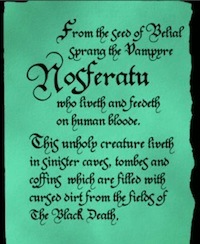 "From the seed of Belial sprang the Vampyre, Nosferatu, who liveth and feedeth on human bloode," it reads. "This unholy creature liveth in sinister caves, tombes, and coffins which are filled with cursed dirt from the fields of the Black Death." Again, this book is another clever intertext that references the epistolary nature of the novel Dracula, as well as simply being an efficient tool for exposition and foreshadowing. The text here, however, is also notable for the way it subtly evokes the collective trauma Murnau is drawing on in Nosferatu: the horrors of the World War (which was fought in fields and trenches) and the devastation of the flu epidemic (echoed here in "the Black Death.")
"From the seed of Belial sprang the Vampyre, Nosferatu, who liveth and feedeth on human bloode," it reads. "This unholy creature liveth in sinister caves, tombes, and coffins which are filled with cursed dirt from the fields of the Black Death." Again, this book is another clever intertext that references the epistolary nature of the novel Dracula, as well as simply being an efficient tool for exposition and foreshadowing. The text here, however, is also notable for the way it subtly evokes the collective trauma Murnau is drawing on in Nosferatu: the horrors of the World War (which was fought in fields and trenches) and the devastation of the flu epidemic (echoed here in "the Black Death.")
Hutter—a creature of reason, and dumb as a bag of rocks—naturally not only ignores this warning, but actually scoffs at it, hurling the book at the floor in amused contempt. It's interesting to note, however—in light of my earlier comments about windows—that the first thing Hutter does in the morning is go to his window and look out: now he is looking out on nature, on a field where horses are running. Now in this "land of phantoms," bathed in the light of the rising sun, Hutter is slightly more attuned to nature, and has left (spiritually as well as physically) the modern, masculine world of rationality. The act, however, also links him with the horses, who are—as Murnau showed us with the hyena—prey: Hutter is entering the dangerous, feminine world of the subconscious, the realm of nightmare.
He arrives in that world officially the next day: his carriage driver will only take him as far as the bridge leading onto Count Orlok's property, and then steadfastly refuses to go any closer to the castle. Hutter must disembark and make his way on foot. "As soon as he crossed the bridge," our unseen narrator tells us, "[Hutter] was seized by the eerie visions he so often told me of…" (Again, these threats are described as "visions," as if they emerge from within, not from without: this, I think, is the Expressionist view, this representation of external horror as an emergence of the inner turmoil and subconscious fears of the individual.)
Like nearly every mythical traveler into Hell, Hutter is met by a dark ferryman—or, in this case, a carriage-driver. The driver and his horses are shrouded—an image that evokes, I think, the Black Plague—but we get just enough of a glimpse of the driver to note his hooked nose, and rat-like face, and hollowed eyes. (If we've seen even a poster for the film, we suspect this might be Count Orlok himself.) On the carriage ride to the castle, Murnau indulges for the first time in some cinematic trickery: the ride itself is artificially sped up, and for one long shot he inverts the negative. These tricks might strike us as a little clunky today, but they were cutting edge then, and their purpose—especially the latter effect—is clear and precise: Hutter has left the reality he knew and entered the underworld, where the rules are different.
The carriage drops him off at outside the dilapidated castle, and as it pulls away at unnatural speed the gates of the castle open by themselves: Hutter enters cautiously, and we get—before he himself does—our first look at the mysterious Count Orlok. He emerges from a dark tunnel, rising up from below, framed—as characters frequently are in the film—in an arch that surrounds him with negative space. Moving stiffly, his hands folded on his chest, he looks like a corpse laid in an invisible coffin.
Hutter follows him down the tunnel, into darkness, into the underworld, and we've reached the end of Act I.
Act II
The second act of Nosferatu is given over completely to Hutter's stay in Castle Orlok, and his (and our) growing awareness of the true nature of his host. Once we get to Act III I'm going to try to pick up the pace a little bit in discussing the remainder of the film, but for this segment I think it's worth taking some time to look at the shot-by-shot construction of individual scenes. Here I'll remind everyone again (as if it's not already painfully obvious) that I'm not film scholar, but even a casual look at Murnau's technique demonstrates why Nosferatu is such a great and landmark film. Many of these techniques seem simple—even self-evident—to us now, after a century of film, but they were remarkably innovative at the time, and incredibly effective.
The act opens on the two men dining together—or rather, with Hutter dining. Orlok, of course, does not eat; he simply sits, ignoring his guest, his face buried in a letter from Knock that Hutter has delivered. (Just in case we haven't already made the leap, the same cabbalistic writing—and the similar physical traits of Orlok and Knock—echo back to the earlier scene and establish the connection between the two villains.)
But the really impressive thing here is how Murnau builds suspense, and puts our steadily growing discomfort in sync with Hutter's own. Throughout this initial sequence there are no intertitles, and, at first, very little music: Erdmann's score provides just a single, suspensefully delayed chord, over and over, creating an increasing sense of unease. Murnau begins with a wide shot of the room—both of them framed in an arch—then moves in for middle shots of Hutter and Orlok; the former is surreptitiously stealing glances at his host, the latter is rudely ignoring his guest. (I should probably mention that you can click on these screenshots to enlarge them, and get a better look at what I'm talking about.)
Then, while Hutter reaches for a knife to cut his bread—still glancing nervously at Orlok—Orlok looks up, and we move in for a close-up of his strange and horrifying face, mostly concealed behind the mysterious writing: he is not looking at Hutter, just staring as he contemplates his own diabolical plans. The music gains complexity and urgency as we move to a close-up of Hutter's face, looking terrified: he has dropped all pretense of not being seriously unnerved, and stares at Orlok like a deer catching sight of a wolf. At this moment, Murnau cuts to a shot of Orlok's strange clock—a symbol of death—just as it strikes midnight.
Again, from our perspective, we may see nothing terribly remarkable in this synergy of composition, editing, and music, but compared to most other silent films of the era—in which scenes tended to play out in a single shot—it is sophisticated and stunning. Murnau was developing the art of editing beyond what had been a more utilitarian narrative approach: instead of simply using the best shot to tell the story clearly, he was intercutting shots to create suspense, mood, and thematic echoes, often using images (like the clock, or the hyena earlier) that serve an evocative or metaphoric purpose more than a narrative one.
The clock, though, does serve a narrative purpose, and triggers the next event in the story: it startles the already nervous Hutter into cutting himself on the knife, an act that draws Orlok's interest for the first time. "You've hurt yourself!" Orlok proclaims. "The precious blood!" He actually attempts to suck on Hutter's thumb, and Hutter—understandably repulsed—backs away from him. There's another marvelous shot of Hutter backing into the frame—moving into the shot, away from the stalking camera—as Orlok follows, and then the erotic element is introduced as the Count, suddenly all charm, attempts to seduce Hutter into staying up with him.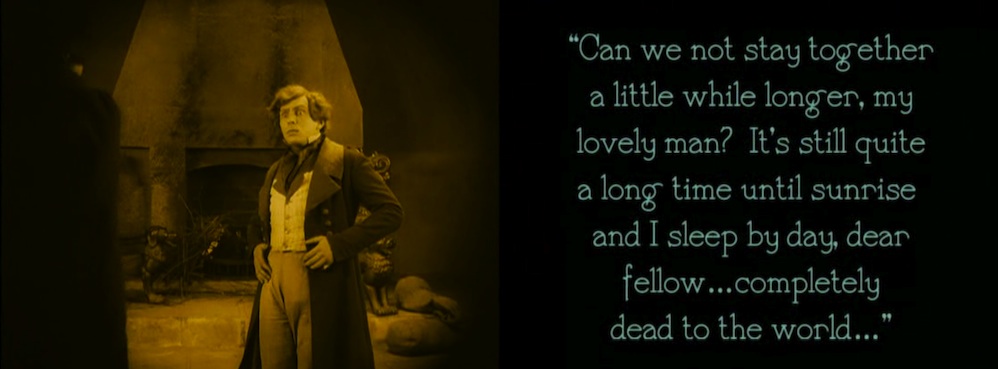
In the morning, Hutter wakes up alone, in the same room, with two puncture marks on his throat. He—dull soul—attributes the bites to mosquitoes, but we of course know that Orlok has succeeded in having his way with the innocent young man.
The next day finds Hutter alone, with the run of the grounds, and we see him happily at peace, enjoying the outdoors and writing a reassuring letter to his wife. There is, I think, a further transition that has happened here, in which Hutter has—through his metaphoric deflowering—become even more connected with nature, with what I have suggested is the more feminine, dreamlike world that is both appealing and threatening. That evening, however, sees the first step in the invasion of this world into Hutter's own, as the two men complete their business transaction and the Count purchases the property in Wisborg. He signs the contract, however, only after lustily gazing at a picture of Hutter's wife that the young man has accidentally dropped.
That night, in his room, Hutter consults his book of vampire lore again, and finally has the realization that Orlok is a vampire. At that precise moment, the death clock strikes midnight again, and the terrified young man looks out his door to see the Count—now in full, ratlike vampire form—approaching his room. As Hutter flees to his bed like a scared child—or a timid virgin—another wonderful sequence begins, as the vampire, who appears far away at first, moves closer and closer until he is at Hutter's door and in his room. (I love the first two shots of the vampire below, in which Murnau dissolves from an extreme long shot of Orlok to one closer in: the vampire has not moved, but he suddenly seems closer and more menacing.)
But then an interesting thing happens: as Orlok approaches Hutter's bed, we cut suddenly to Ellen, who bolts upright in her bed back in Wisborg. It's an interesting (and telling) variation on Stoker's story: in Dracula, Mina Harker has a telepathic connection to Dracula after he bites her; here, however, Ellen seems to have such a rapport with Hutter without any such supernatural connection: she is simply the feminine side of his soul, and senses the danger he is in. She rises from her bed to go out the window—windows, again—to sleepwalk towards him in the dreamworld.
The people with whom she is staying pull her in and call a doctor, but Ellen maintains her connection, calling out to Hutter. Orlok now senses her too, and withdraws from Hutter's room without killing him. (Note the brilliant use of eyeline matching in those final two shots, which establishes the connection between Orlok and Ellen; though they are in different shots and in completely different places, they seem to be looking at each other.) What exactly has happened is open to interpretation: has Ellen vanquished him from hundreds of miles away? Has Orlok just decided he would rather have the wife than the husband? Has he been moved by her love, and taken pity on Hutter at her request? Or have Orlok and Ellen struck an unspoken deal, in which she has offered herself as sacrifice to save her husband's life? (It is interesting that, from this point on, Ellen's psychic rapport will be with Orlok, not Hutter.)
However you interpret it, it seems to me that—simply from a storytelling perspective—this intercutting between events represents a great leap forward for the art of cinema. Nothing in the "narration" or dialogue of Nosferatu ever explains what exactly has happened here, and in fact I think what it means—thematically, as well as literally—is a richly ambiguous matter. The important thing, however, is that Murnau first teaches the audience to visually process such associative juxtapositioning—establishing a narrative chain of causality between events taking place simultaneously in two different places—and then asks, and trusts, the audience to figure out, or intuit, what it all means. It is an excellent example of the way Murnau marries his naturalistic cinematic technique with a more subversive Expressionist vision: he seems to be portraying the world we know realistically, but the world of his film actually operates on the mythical, dreamlike logic of the subconscious. Murnau is using this new art form to do more than tell straightforward stories: this is an elevation of the medium towards art.
On the morning following this scene, Hutter—presumably seeking a way to leave the castle—stumbles into a cellar in the castle, and discovers the vampire asleep in his coffin: he is horrified, and—pathetic fool that he is—leaves without even attempting to harm Count Orlok. (In light of the erotic undertones of Nosferatu, this scene is interesting in the way that it parallels Orlok's visit to Hutter's bedchamber the previous evening: in each case, the visitor finds the occupant completely vulnerable in his bed, and in each case leaves without doing anything—without consummating, if you will, the visit.)
That night, Hutter sees Orlok load his coffins onto a carriage, and depart at high speed for Wisborg—and, of course, for Ellen. Trapped in the castle, Hutter's only egress is the window of his tower bedroom, which looks out over a sheer cliff face with raging waterfalls below: it is a leap of faith, a jump into the dangerous, natural underworld. He ties his bedsheets together, lowers himself as far as he can, and falls, unconscious, onto the rocks.
Act III
As promised, I'm going to pick up the pace for the remainder of the film: partially because I want to get out of this post in less than 10,000 words; partially because I think we've already discussed (in my shallow, haphazard way) many of the important themes and techniques; and partially because it is around here that Nosferatu begins, for me, to go off the rails in places.
The centerpiece of Act III is Orlok's journey, by sea, towards Germany: it is indeed a brilliant sequence, and we'll discuss it a bit below. Padding out this act, however, are two of the characters I find most problematic in Galeen's retelling of Dracula: Knock (the Renfield character) and Bulwer (the Van Helsing character).
We've glimpsed both of them before; I discussed Knock's earlier, fairly substantial scene above, but Bulwer also makes a blink-and-you-miss-it appearance early in the film, when he greets Hutter as the young man hurries through the town. ("Not so fast, young man," he says, jokingly. "No one can outrun their fate.")
Here we see Prof. Bulwer lecturing his students on the mysterious and horrible workings of nature, and specifically on creatures that suck the life-force from others: he shows them a venus flytrap catching a fly, and a polyp catching prey in its tentacles.
The connection to our main subject is obvious. ("Like a vampire, no?" Bulwer asks his students, in case we miss it.) And there are even some nice visual echoes, with the cilia of the plant reminding us of Orlok's teeth, and the tentacles of the polyp his fingers.
Intercut with these scenes are shots of Knock, who has been committed to an asylum, having gone increasingly mad at Orlok's imminent approach. Like Renfield in Dracula, Knock has taken to eating insects, snatching flies from the air and bonding with the spiders in his cell who trap insects in their webs and drink their blood. (It's worth noting here that the "Jewish spider" was another popular anti-semitic image in Weimar Germany.)
Again, the parallels are obvious, and this is not necessarily a problem: this kind of non-essential, associative commentary on the themes of the main narrative was one of Murnau's many innovative choices, and it does add additional layers to Nosferatu. Bulwer in particular, I think, serves a thematic purpose: he represents the limitations of logic, the man of science attempting (futilely) to understand and categorize the workings of nature.
No, my issue with Knock and Bulwer is that they serve only thematic purposes: they have absolutely no function in the story. Unlike their Dracula counterparts—the vampire-hunter Van Helsing (who is instrumental in the defeat of the Dracula), and Renfield (who serves Dracula, and eventually betrays him to protect Mina), neither of these idiots even interact with Orlok, or Ellen, or anyone else in the story. They serve no purpose in Nosferatu except to provide this thin thematic commentary. (If these scenes were the extent of their screen-time, I wouldn't complain, but a truly ridiculous amount of Act V is dedicated to Knock, and none of it means much of anything: it feels like filler.)
Anyway, enough of my complaints: on to the good stuff. From these scenes we cut to some truly gorgeous shots of Ellen, sitting on the beach and communing with nature. It's interesting that the intertitle tells us she is "pining for her beloved." We take this to mean, of course, that Ellen is pining for Hutter, but she has no reason to believe her husband will come by sea—and in fact he won't. The one coming by sea is Orlok, whose approach we suspect she—like Knock—can sense. (Note the way she is surrounded by crosses—which traditionally ward off vampires—but she sits between them, leaving a passage wide-open between herself and the sea: the waves seem to be channeling straight towards her.)
It is impressive how many balls Murnau keeps in play here: while all of this is happening, we also check in on Hutter, who has been convalescing in a convent and is now ready to leave for home: his journey will be intercut with everything else that is happening. Meanwhile, Knock has picked the pocket of his guard, and discovered (conveniently) a notice about a "plague" in the port towns of Transylvania—a plague that leaves its victims with strange marks on their throat—and is thus able to trace his master's progress towards Germany.
This notice makes a nice transition for us to go out to sea, for one of the best sequences in the film: Orlok's voyage aboard the schooner Empusa, bound for Wisborg. Murnau gets some fantastic shots of the ship and the ocean here—which I can only assume would have staggered audiences used to studio-bound productions—but the real beauty of this segment is the slow build-up of tension aboard the ship, as first one, then several, then all the crew slowly succumb to the mysterious "sickness." (In one of the most memorable shots of the film, one of the feverish crew members has a ghastly vision of Orlok, who otherwise does not appear for most of the voyage: at this point he is simply a spectral presence haunting the ship, picking off crew members one by one.
Finally, there is no one left but the captain and the first-mate. The captain stays at the helm, while the first mate goes below to investigate what's in those mysterious boxes they've been hauling. He chops into one of the crates with a hatchet, and rats start pouring out. Again, the rats serve double-duty as far as metaphors go: obviously, they symbolize plague, and the fear of disease; more importantly, however, the rats symbolize the German people's fear of swarming, socially-parasitic immigrants—specifically, Jews—coming from Eastern Europe to infect the West. (Caricaturing Jews as rats, of course, was also common in the anti-semitic propaganda of Weimar Germany: there's no chance Murnau's audience would miss the racial coding here.)
Finally, the first mate removes one more lid, and the vampire rises—stiffly, unnaturally—from his coffin. (Those choosing to harp on the sexual metaphors at work in the film can certainly seize on the rather…stiffly erect…way that Orlok rises to attention.)
The first-mate flees above deck, choosing to throw himself overboard rather than spend one more second on the ship with this thing. The captain, resigned to his fate, lashes himself to the wheel, as Orlok emerges and we get what is probably the best, and most memorable, shot of the film:
We do not see Orlok kill the captain—we do not see Orlok kill anyone—but we don't need to: this fantastically creepy sequence ends with the vampire moving across the deck—framed in rigging, the spider in his web—and Act III ends with an ominous title card reading "The deathship had a new captain."
Act IV
Okay, this time I'm really going to pick up the pace—especially since, as previously mentioned, most of Act IV and a lot of Act V seems like filler to me. But a few comments…
This act opens with a lot of clever intercutting: Hutter rushing home, the Empusa making its way to port, and Ellen staring out the window in anticipation of…both? "I must go to him," she says. "He's coming!" Again, the assumption is that she's excited about her husband's return, but again, the editing here is curious: it's a shot of the sea that immediately precedes her statement. Again, it seems to be Orlok's approach she's sensing, and his lure she's feeling.
Meanwhile, Knock, too, has sensed Orlok's approach, and takes this opportunity to kill his guard and escape. While he's doing this, the Empusa has drifted into port, eerily, with no living soul on board: at nearly the same moment as Hutter arrives home, Orlok sneaks off the boat, carrying his coffin across town to the empty house he has purchased.
The discovery of the empty ship—and the rats on board—prompts a lengthy investigation from the town officials, who read the ship's log, examine the bodies on board, and declare a plague emergency in Wisborg.
Act V
The final act of Nosferatu opens with a beautifully shot, ominous sequence: undertaker's men marking doors with crosses—to indicate houses effected by the "plague," and then carrying a coffin from one of the homes. (As it has been throughout the movie, the play of light and shadow—both aesthetically and thematically—is precisely and gorgeously achieved, with the figures in black, the houses in shade, and the sunlight gleaming off the lid of the casket.)
Back in her home, Ellen has discovered Hutter's book of vampire lore: an intertitle tells us that her husband had "made her promise not to touch the book which had caused him such frightening visions," but that Ellen "found it's strange force irresistible." She pours over the forbidden text in secret, at night, and the expression on her face as she reads of the Nosferatu is almost one of ecstasy.
"Deliverance," she learns, is possible only if an "innocent maiden maketh the vampire heed not the first crowing of the cock," a diversion accomplished by "the sacrifice of her own bloode." Here is perhaps Murnau and Galeen's greatest (and most significant) departure from Bram Stoker's novel: in Dracula, the men gather to kill the vampire through violence, but here there is no other way to kill him but through feminine power. She must lure him to her bed, and keep him there—through the "sacrifice of her blood"—until morning. (I won't belabor the paper-thin sexual metaphor here: I think we all get it.) Her power is immediately reinforced, as Hutter discovers her reading the book, sees Orlok peering from his window across the street, and immediately collapses on the bed like a baby: Ellen is scared, but Hutter is the one who falls apart.
Meanwhile, an intertitle tells us, "Fear lurked in every corner of town. Who was still healthy? Who was sick?" We see shots of townsfolk falling ill, including the wife of the couple with whom Ellen stayed. (This would be the film's counterpart to Lucy in Dracula, but she's barely a character here.) Ellen watching from her window, sees a parade of undertakers carrying coffins up the street.
She goes back to the book, reads again the section about how to slay the vampire, and we see a steely resolve come over her face.
The fear and paranoia that have overtaken the town now comes to a peak, as the townsfolk chase the escaped lunatic Knock all over Wisborg. This sequence is one of my pet peeves of the film, as it's indulgently long, narratively unnecessary, and thematically fuzzy. Again, Knock has served no function in the plot: he seems to worship Orlok, but he's done nothing to help him since selling him a house, and whether he's caught or not doesn't really matter. At the same time, however, Murnau seems to want to say something about how fear creates a mob mentality, and so he uses Knock to do it: we see old women gossiping about how Knock killed his guard, and how he's a vampire. Soon, the menfolk of Wisborg are throwing rocks at Knock and chasing him through the streets.
There seems to be a tone of judgment in Murnau's depiction of these events. ("The town was paralyzed by fear," an insert tells us. "They were looking for a sacrifice. They chose Knock.") It would be nice to think that Murnau was, finally, inserting a message about fear, prejudice, and paranoia here, and perhaps he is. However—given the rest of the film—I find it problematic and unconvincing. After all the blatantly anti-semitic imagery throughout the movie—which Murnau has used to ramp up the fear—it's a little late in the game to be chastising the people of Wisborg for their prejudices. Besides, as scapegoats go, Knock is a pretty fair candidate within the story we've been told: he did murder his guard, and he did help bring this danger down on the town in the first place. Honestly, this whole segment feels like an unnecessary and unearned feint at social-commentary that the film would be better off without.
But it's a minor complaint, and I suppose an argument can be made that the Knock's role here is to allow for a contrast between the masculine and feminine approaches to dealing with monsters: in this regard, the Orlok/Knock relationship parallels the Ellen/Hutter doubling, with the first figure in each pair representing the power—which I've suggested is tied to feminine energy, nature, and the unconscious—and the second the completely ineffectual lack of power that comes with masculine energy, urbanity, and logic. (Certainly the fates of Knock and Orlok follow this trajectory: the former is defeated—for no real purpose—by a mob of men, and the second is destroyed by a woman.) It is also, perhaps, a prioritizing of the individual over the societal: the collective response to the crisis is wrong-minded and futile, while it is the personal understanding—and sacrifices—of one person that ultimately saves everyone.
So let's look, finally, at that event. While the idiot men are off chasing Knock, and while her idiot husband is asleep in the chair in her bedroom—he is not in the bed with her, significantly—Ellen bolts awake, and goes, once more, to the closed window. The light through her thin nightdress outlines her body—to a degree I have to assume was slightly risqué in 1922—and she gazes out to see her faithful undead paramour staring back at her—waiting—from across the street.
She seems to have a brief moment of indecision, in which she looks to her husband asleep in the chair, and then she turns…and flings open the window. Across the way, Orlok has understood: he has been invited.
The ambiguity in this scene is nothing short of brilliant. Audience members who chose to see a noble German woman sacrificing herself to save her husband and town from the satanic Jew can come away from this scene perfectly happy: in that version, she looks at her husband, realizes how much she loves him, and decides to die for him. However, those of us who might see a different reading—such as Ellen's rejection of sexual repression, her longing for an erotic awakening, and her choosing the primal, animalistic force of Orlok over her insipid, chair-sleeping husband—can also find plenty here to support our case. (In that reading—my reading—she has her moment of indecision, and looks at her husband, and thinks to herself, God, he's hopeless, how have I lived with him this long? Bring on the fangy foreigner! )
Whether you interpret it as a sacrifice, or as a surrender to seduction—and I think versions of both readings are intended— it works: she sends Hutter away (by feigning sickness, and asking him to fetch the useless Prof. Bulwer), and lures the vampire to her chamber, inviting the demon into her bed and the darkness into her soul. The creature climbs the stairs, and here he is all darkness: Murnau shows us not him, but just his shadow, as he approaches Ellen's chamber—and then again as he approaches her bed, just a shadowy claw reaching out to seize her heart. (Note how Ellen herself is now completely surrounded in shadow: this is—literally and figuratively—one of the darkest shots in the whole movie.)
When next we see them, however, the embrace is wholly physical: Orlok cradles her like a lover, drinking deeply from her throat. He has been so engrossed in their coupling that he has, indeed, missed the crowing of the cock—no puerile puns, please—and the shifting in tint indicates that the sun has risen.
Realizing his mistake, Orlok tries to do the walk of shame past the open window and slink back to his coffin, but the light of the sun touches him, and he disappears in a wisp of smoke. Ellen wakes up—looking rather elated—and Hutter returns just in time to hear her call his name and then die in his arms. An insert informs us that "the truth bore witness to the miracle, and at that very moment the Great Death came to an end…"
Conclusion
As I mentioned when I began, it took me a while to warm up to Nosferatu. I think this reaction was partially due to some of the issues we've discussed: the time spent on non-essential characters, the constant thread of anti-semitism, etc. However, I think is was also a failure of expectations on my part, an inability to meet the film on its own terms. I did, and do, have problems with the story, but hopefully it's clear by now that the story—which, ironically, got the filmmakers in such legal and financial trouble—is the least important element.
Last week we discussed German Expressionism a little bit, and, as I've said, Nosferatu is widely considered a masterpiece of the movement. On the surface, however, the film does not appear to fit easily into any but the loosest definition of this already loosely-defined term. The conscious embrace of artificiality—as demonstrated so brilliantly in Caligari—is almost nowhere to be seen here: in fact, for most of the film, Murnau achieves as natural and realistic effect as anyone with a camera had attempted at the time. He films almost entirely on real locations, with what seems to be natural light. The performances of his actors are more internal, and less exaggerated, than in most silent films of the era, and considerably more natural than in other, more obviously Expressionistic works like Caligari. He even employs local, non-professional actors as extras and in minor roles, which gives certain scenes an incredible authenticity. The Expressionists' core tenet of rejecting even the attempt to objectively represent external reality seems to be nowhere in evidence.
And yet I think this is where Murnau fooled me, and initially set my expectations at odds with the film: Nosferatu’s surface realism, and its comparatively sophisticated filmmaking techniques, lulled me into expecting what I would think of as a more straightforward—or even a more "modern"—movie-viewing experience than I'd had with Caligari. From that perspective—as a vehicle for effective, linear storytelling—Nosferatu seemed, on first viewing, rather flawed to me: its plot unfocused, its characters under-developed, its causalities unclear, and its resolution rather unsatisfying.
And yet, on subsequent viewings, what I've realized is that Nosferatu is a film that is Expressionistic in its intent, and its effect, more than in its techniques. From a purely technical level, here's a simple example of what I mean, from the end of Act IV: a simple shot of a town crier walking slowly down the street outside the Hutter's home, to read an announcement about the "plague." There's no obvious artifice here, and yet Murnau captures in natural light the kind of threatening shadows and jaggedly divided space that Weine, in Caligari, would have painted on his sets for thematic effect. It's a beautiful depiction of a city upon which the shadow of death has fallen, and a perfect metaphor for souls divided, half-consumed by an encroaching evil or corruption. (Note how clean and innocent the houses on the left look, and how decayed and damned the houses on the right seem.) It's realistic, but it's a sort of selected realism that is perfectly in service of the Expressionistic themes and emotions of the piece. It's Expressionism not as a way of creating, but as a way of seeing.
And that, I think now, is how all of Nosferatu works, and that's its special genius: I don't pretend to have sorted it all out, but I do know that there are things going on here—about gender, about sexual desire, about fear of the other, about the conscious and the sub-conscious—that are happening on a deeper level than I've begun to scratch.
For all its apparent realism, and its relatively faithful use of one of the strongest and most famous stories in literature, Nosferatu is more symphonic than novelistic, more poetic than narrative, more an expression of the internal soul than of the external world: it prioritizes visual evocation over narrative development, psychological themes over societal ones, and its logic is not so much linear as associative. Murnau distills the powerful story of Dracula to its most mythopoetic, psychologically resonant components, and turns a straightforward yarn about vampires into something that speaks to us—like opera, like music, like myth—on a deeper, more fundamental level. As the French critic Lotte Eisner wrote of Nosferatu, "Never again was so perfect an Expressionism to be attained, and its stylization was achieved without the aid of the least artifice."
Coming Up on the Syllabus: Next week, we take what I certainly hope will be a much shorter look at Sergei Eisenstein's Battleship Potemkin, widely considered one of the most influential—or at least most often quoted—films of all time. (For those of you who want to do the reading in advance, it's on YouTube and streaming on Netflix for free, though I can't speak to the quality of the prints. The restored Kino print—which is what I'm going to watch on DVD—is also available for streaming rental on Amazon.) Then, in the next few weeks, I'll be doing Fritz Lang's Metropolis, and Carl Theodore Dryer's The Passion of Joan of Arc, before moving on to those newfangled movies with sound.
Bibliography
A number of links to useful articles on the web—in no particular order—that I consulted as I was writing this post:
"Nosferatu: Resurrection of the vampire," The Independent
"Nosferatu at 90: The Jew as Vampire," Vault of Horror
""Imaginary Vampires, Imagined Jews," Allan Nadler, Jewish Ideas Daily
"Nosferatu: A Filmarchaeology," CeltoSlavica
"Six Degrees of Nosferatu," BFI Sight and Sound
"Nosferatu and the Occult(ists)," Raymond Owen, Raymond Owen
"Dracula vs. Nosferatu: A True Copyright Horror Story," Jonathan Bailey, Plagiarism Today
"The Undead: Nosferatu," The Fine Art Diner
"German Expressionism," David Hudson, GreenCine
"Nosferatu (1922)," Roger Ebert, The Chicago Sun-Times
"Nosferatu," Felicia Feaster, Turner Classic Movies
"Nosferatu, eine Symphonie des Grauens," Michael Koller, Senses of Cinema
German Propaganda Archive, Calvin College
Wikipedia pages—Oh, don't pretend you don't use it, too—on F.W. Murnau, Albin Grau, Nosferatu (the film), and "Nosferatu" (the word)

![Knock (Alexander Granach) [Click to Enlarge] Knock (Alexander Granach)](https://unaffiliatedcritic.com/wp-content/uploads/2013/01/Knock-Alexander-Granach1.jpg)
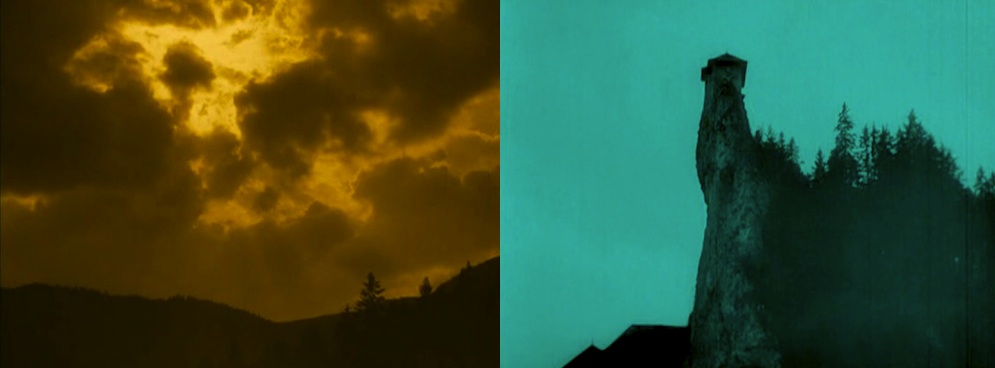
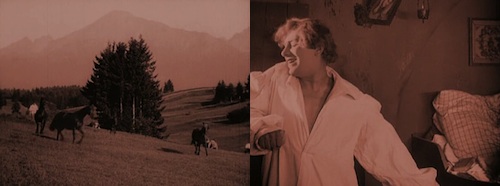
![The Mysterious Carriage in NOSFERATU [Click to Enlarge] The Carriage Ride](https://unaffiliatedcritic.com/wp-content/uploads/2013/01/The-Carriage-Ride1.jpg)
![First appearance of Count Orlok (Max Schreck) [Click to Enlarge] Count Orlok (Max Schreck) Appears](https://unaffiliatedcritic.com/wp-content/uploads/2013/01/Count-Orlok-Max-Schreck-Appears.jpg)
![Hutter Dines with Count Orlok [Click to Enlarge] Hutter Dines with Count Orlok.](https://unaffiliatedcritic.com/wp-content/uploads/2013/01/Hutter-Dines-with-Count-Orlok2.jpg)
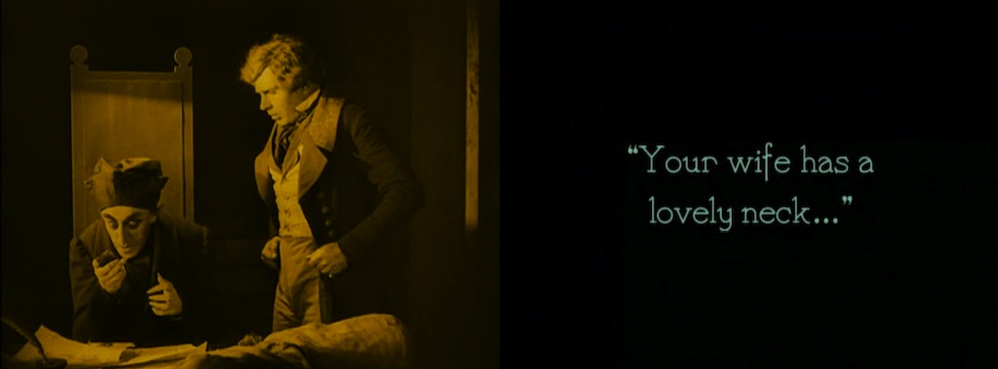
![Orlok comes to Hutter [Click to Enlarge] Orlok comes to Hutter](https://unaffiliatedcritic.com/wp-content/uploads/2013/01/Orlok-comes-to-Hutter.jpg)
![Ellen saves Hutter [Click to Enlarge] Ellen saves Hutter](https://unaffiliatedcritic.com/wp-content/uploads/2013/01/Ellen-saves-Hutter.jpg)
![Hutter visits Orlok's bedroom [Click to Enlarge]](https://unaffiliatedcritic.com/wp-content/uploads/2013/01/Hutter-visits-Orloks-bedroom-Click-to-Enlarge.jpg)


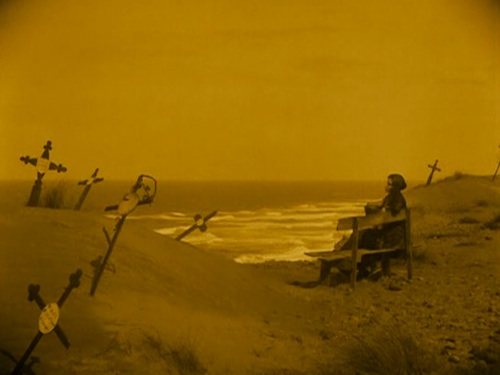
![The Voyage of the Empusa The Voyage of the Empusa [Click to Enlarge]](https://unaffiliatedcritic.com/wp-content/uploads/2013/01/The-Voyage-of-the-Empusa.jpg)

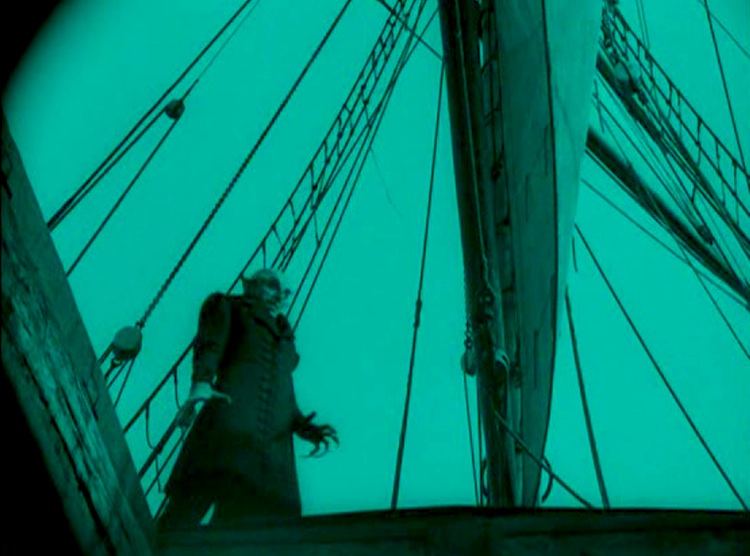
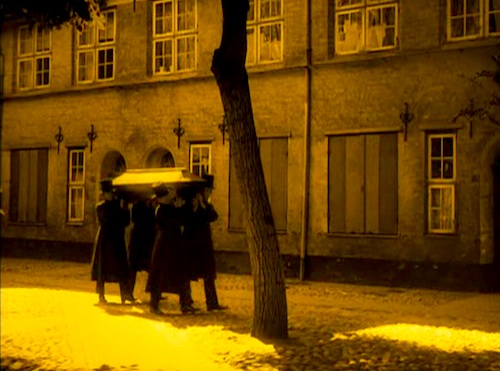

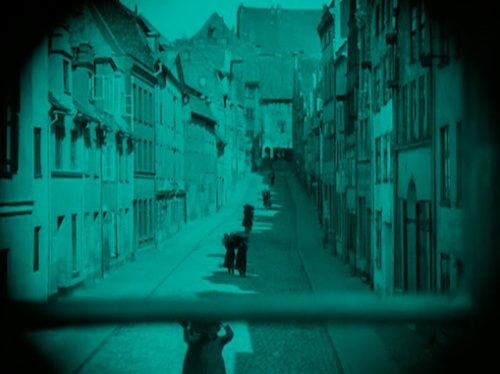
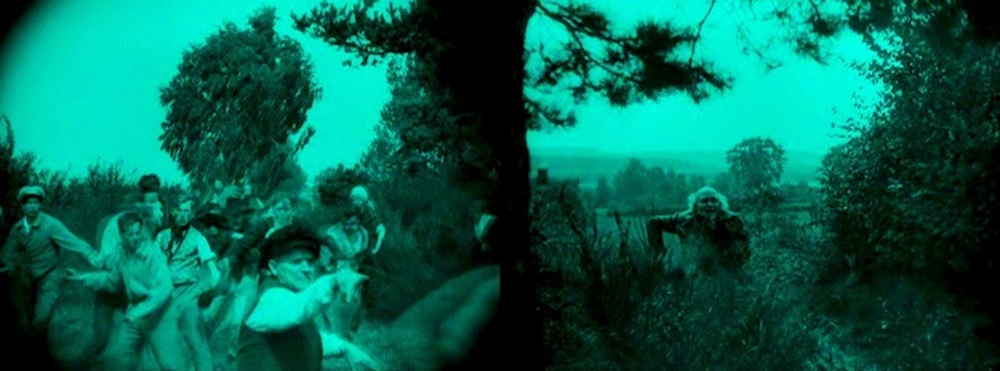
![Ellen makes her choice [Click to enlarge]](https://unaffiliatedcritic.com/wp-content/uploads/2013/01/Ellen-makes-her-choice.jpg)
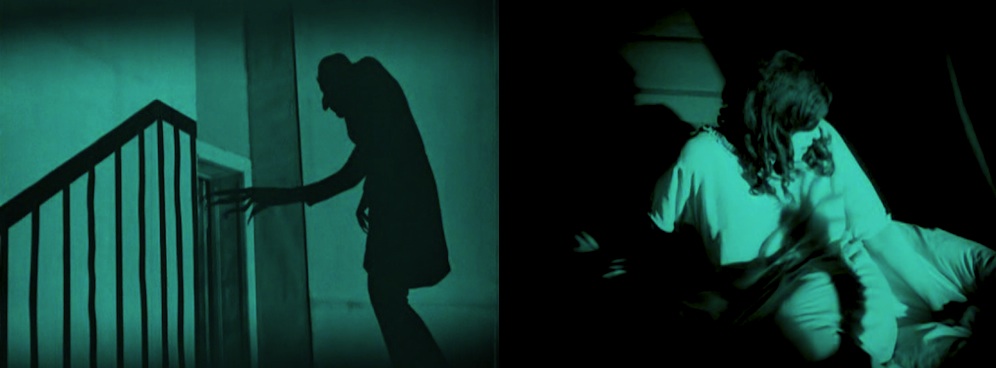
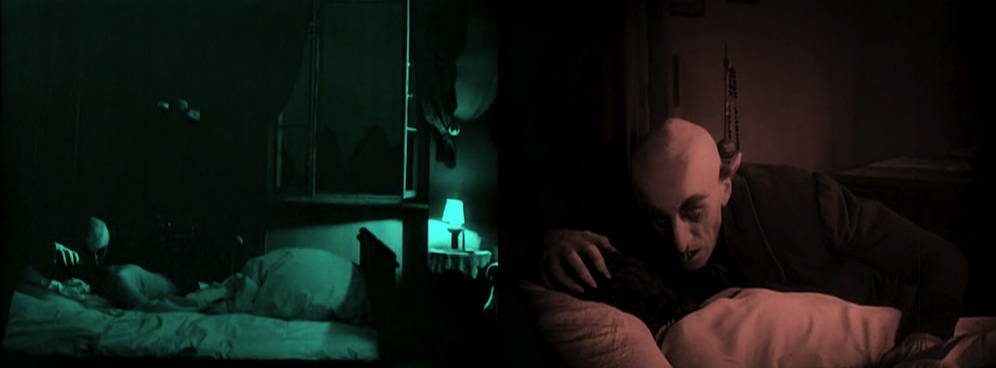

5 thoughts on “NOSFERATU (1922)”
One of my favorite films — and thank you for the extremely in-depth analysis! For advanced study, of course check out Werner Herzog's remake. It's not as good — how could it be? — but it's not completely gratuitous either. One smart Genman filmmaker reinterpreting another.
Keep up the great "over analyzing." For my money, the vampire image presented in "Nosferatu" (bald head, big pointy ears, blank eyes, and overly long fingers) is by far the scariest in film history. "Salem's Lot" borrows from this? A couple weeks ago I listened to a podcast about mirrors (a sometimes symbol of the occult), and there was a bit about Orlok and Ellen's interaction with a mirror. Think I could remember it all? No, but it had something to do with vanity and awareness of death.
Pingback: March 5: Nosferatu | Jewish Currents
Pingback: Expressionism (1940s Film Noir – #AtoZChallenge) - The Old Shelter
Looking forward to traveling to Slovakia and visiting Orava Castle, where the filming was done. Many shots of “Romania” were actually in Slovakia, as you all may already know.